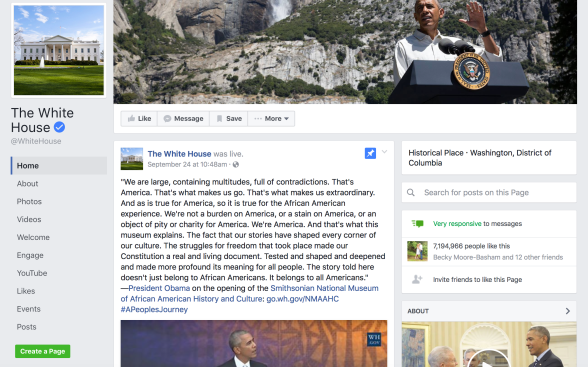What emerging media means for government public relations
Before the Web 2.0 era, citizens could reach out to government officials/agencies through traditional routes of phone or mail. Today, all it takes is an Internet connection. Through social media, citizens are engaging in an open environment where the government can not only share important information, but facilitate transparent, two-way conversation.
Research indicates that Americans are looking for this type of interaction as 14% use social media to find information about a federal agency, while 30% use social media to ask the government a direct question or to resolve an offline issue.
Tools used by the public sector may include social media platforms such as Facebook, the biggest social media network on the Internet. Through Facebook, governments can engage citizens, post events and news and share photos and short videos in real-time.
One example of the federal government working to communicate with constituents is The White House Facebook page. Through this medium, The White House provides live feed to events, creating a deeper connection between this high office and the people of America.
Twitter – a microblogging platform – is also important to sharing information with the public. For example, people who follow the Centers for Disease Control and Prevention (CDC) can find updates on the Zika virus, and can take part in conversations on public health concerns by using the hashtag #PublicHealthChat.

In addition, Twitter can be useful in communicating information during an emergency. One article notes a 2011 example in which Twitter helped notify residents of an earthquake before it hit. This allowed people to prepare for the shockwaves as the traditional alert system would take minutes (versus seconds).
YouTube
According to YouTube, a government entity can use this platform to “strengthen [its] online presence, control [its] story and engage [its] audience wherever they are.” Like Facebook and Twitter, this tool can be beneficial as government agencies work to connect with audiences and bridge the gap with the “more than 1 billion unique users [who] visit YouTube each month.”
One state agency using this forum is the West Virginia Department of Health and Human Resources. Through its YouTube channel, the Department works to highlight important services such as Help4WV, a 24-hour behavioral health hotline. It also posts each segment of its television show, “The State of Health.”
The agency also used emerging media tools to spread relevant information to residents impacted by the June 23 flooding. While internally DHHR shared information with workers in county offices via email and phone calls, the Department wanted to ensure that the those affected by the disaster were aware of resources that could help them. The Commissioner for the Bureau for Children and Families quickly recorded a special message which was posted to the Department’s social media accounts to spread awareness on a special program available to qualifying victims to help them replace food lost in the flood.
Implications of government social media
Facebook, Twitter and YouTube are just a few emerging media tools utilized by government agencies. These innovative platforms can be powerful in improving transparency and overall relations with the public. What do you think? Should all government agencies utilize these forums? Are there risks in using/not using them?












